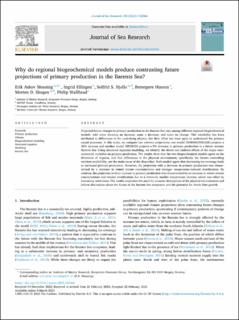| dc.contributor.author | Mousing, Erik Askov | |
| dc.contributor.author | Ellingsen, Ingrid Helene | |
| dc.contributor.author | Hjøllo, Solfrid Sætre | |
| dc.contributor.author | Husson, Berengere | |
| dc.contributor.author | Skogen, Morten D. | |
| dc.contributor.author | Wallhead, Philip | |
| dc.date.accessioned | 2023-09-04T10:19:30Z | |
| dc.date.available | 2023-09-04T10:19:30Z | |
| dc.date.created | 2023-03-17T11:12:39Z | |
| dc.date.issued | 2023 | |
| dc.identifier.issn | 1385-1101 | |
| dc.identifier.uri | https://hdl.handle.net/11250/3087274 | |
| dc.description.abstract | Projected future changes in primary production in the Barents Sea vary among different regional biogeochemical models, with some showing an increase, some a decrease, and some no change. This variability has been attributed to differences in the underlying physics, but little effort has been spent to understand the primary causal processes. In this study, we compare two extreme projections: one model (NORWECOM.E2E) projects a 36% increase and another model (SINMOD) projects a 9% decrease in primary production in a future warmer Barents Sea. Using structural equation modeling, we identify the direct and indirect effects of the major environmental variables on primary production. The results show that the two biogeochemical models agree on the directions of impacts, and that differences in the physical environment, specifically the factors controlling nutrient availability, are the main cause of the disparities. Both models agree that decreasing ice-coverage leads to increased primary production. However, the projection with a decrease in primary production was characterized by a decrease in winter nitrate concentrations and stronger temperature-induced stratification. By contrast, the projection with an increase in primary production was characterized by an increase in winter nitrate concentrations and weaker stratification due to a relatively smaller temperature increase which was offset by increasing wind stress. The results emphasize the need for accurate descriptions of the physical environments and inform discussions about the future of the Barents Sea ecosystem and the potential for Arctic blue growth. | en_US |
| dc.language.iso | eng | en_US |
| dc.publisher | Elsevier | en_US |
| dc.rights | Navngivelse 4.0 Internasjonal | * |
| dc.rights.uri | http://creativecommons.org/licenses/by/4.0/deed.no | * |
| dc.subject | Primary production | en_US |
| dc.subject | Climate | en_US |
| dc.subject | Biogeochemical modeling | en_US |
| dc.subject | Structural equation | en_US |
| dc.subject | Modeling | en_US |
| dc.subject | Barents Sea | en_US |
| dc.title | Why do regional biogeochemical models produce contrasting future projections of primary production in the Barents Sea? | en_US |
| dc.title.alternative | Why do regional biogeochemical models produce contrasting future projections of primary production in the Barents Sea? | en_US |
| dc.type | Journal article | en_US |
| dc.type | Peer reviewed | en_US |
| dc.description.version | publishedVersion | en_US |
| dc.rights.holder | © 2023 The Author(s). Published by Elsevier Ltd. This is an open access article under the CC BY license (http://creativecommons.org/licenses/by/4.0/). | en_US |
| dc.source.volume | 192 | en_US |
| dc.source.journal | Journal of Sea Research | en_US |
| dc.identifier.doi | 10.1016/j.seares.2023.102366 | |
| dc.identifier.cristin | 2134698 | |
| dc.relation.project | The EEA and Norway Grants Fund for Regional Cooperation: RO-NO-2019-0520 | en_US |
| dc.relation.project | Framsenteret: Ocean Acidification Flagship | en_US |
| dc.relation.project | Sigma2: ns9630k | en_US |
| dc.relation.project | Sigma2: nn2967k | en_US |
| dc.source.articlenumber | 102366 | en_US |
| cristin.ispublished | true | |
| cristin.fulltext | original | |
| cristin.qualitycode | 1 | |

